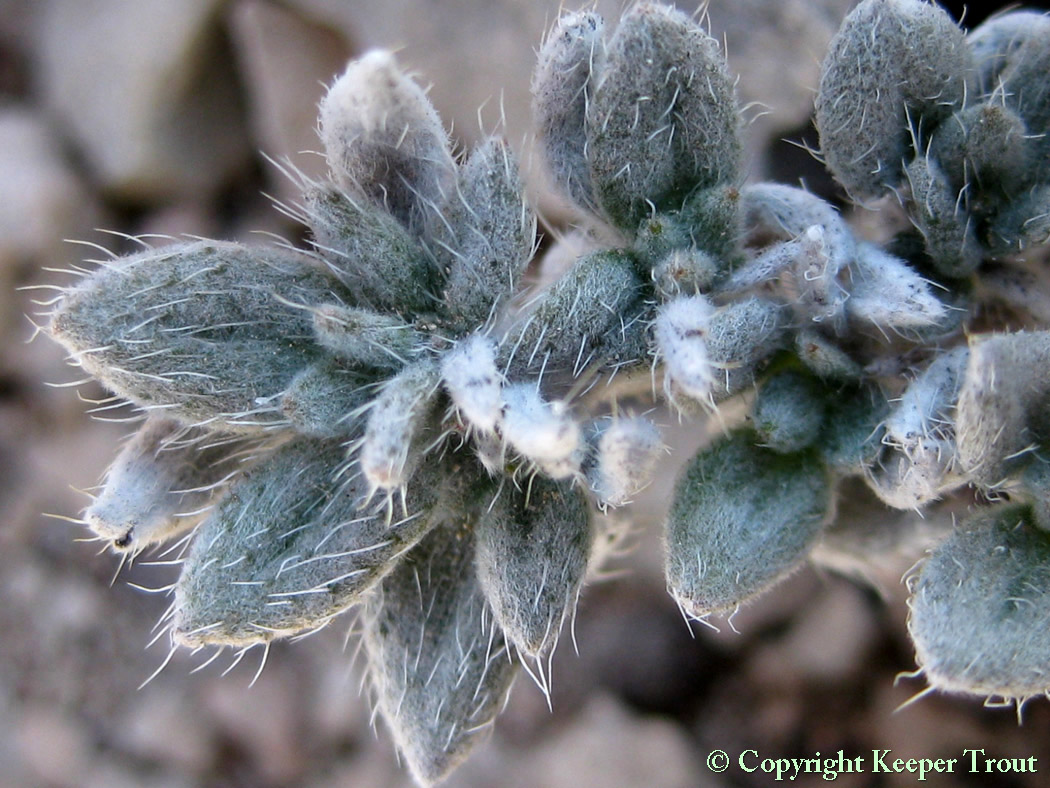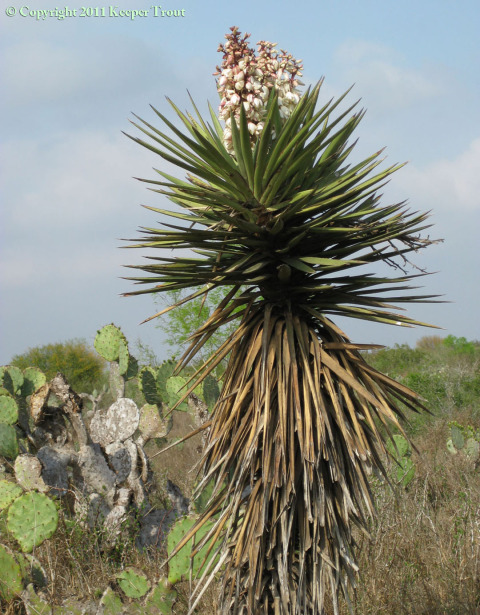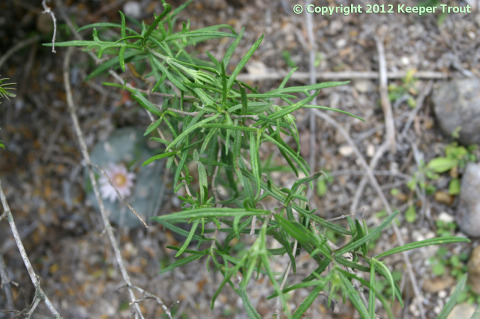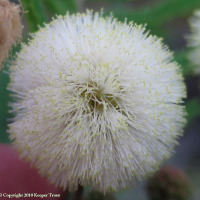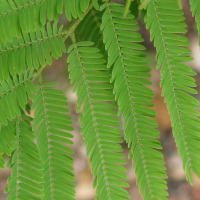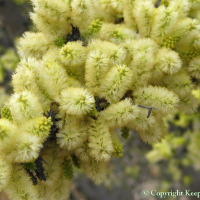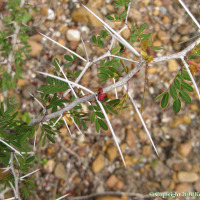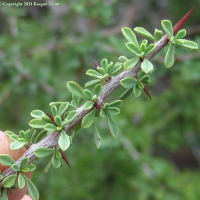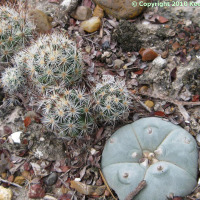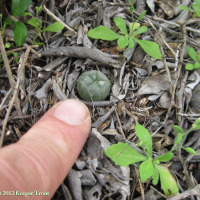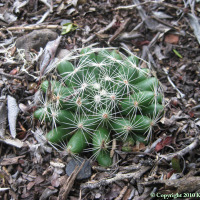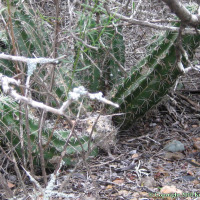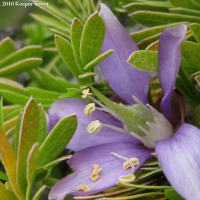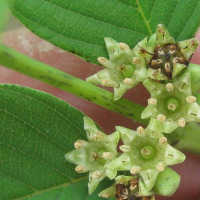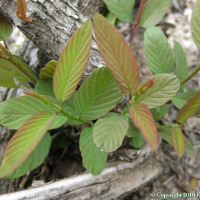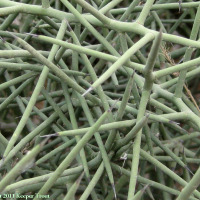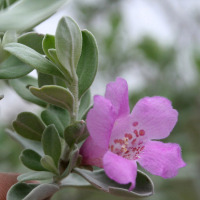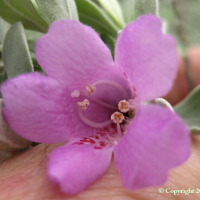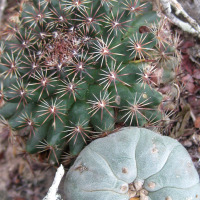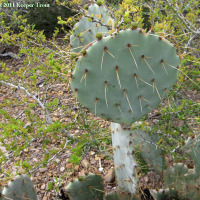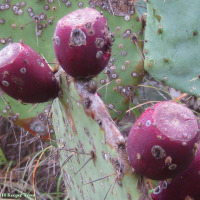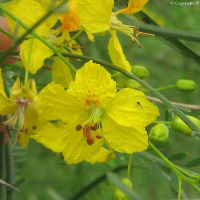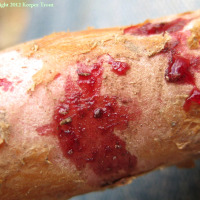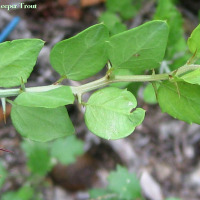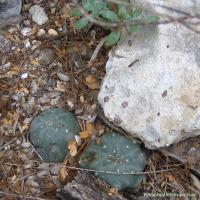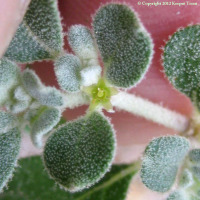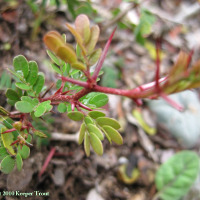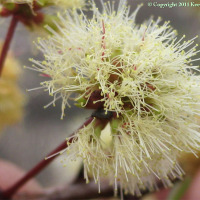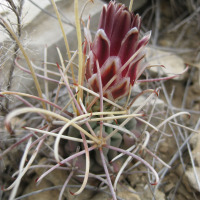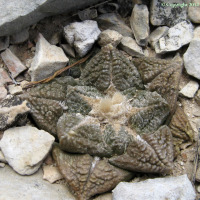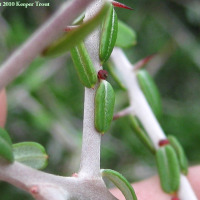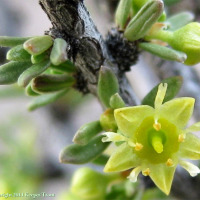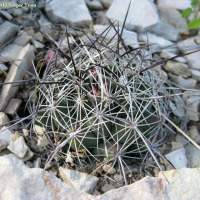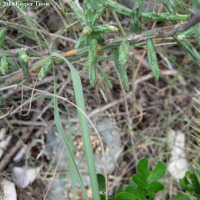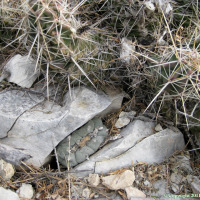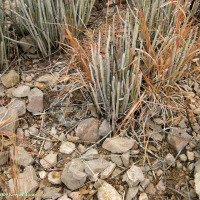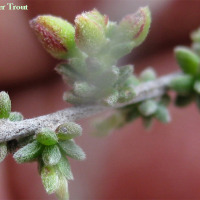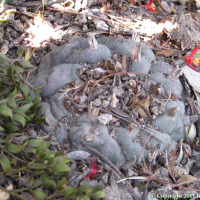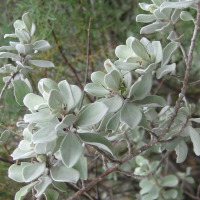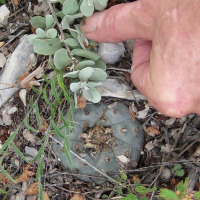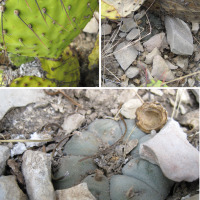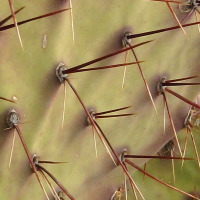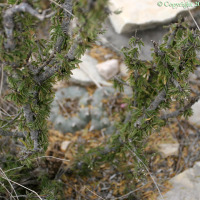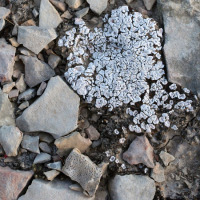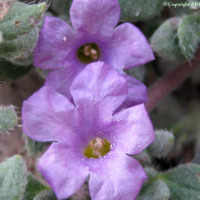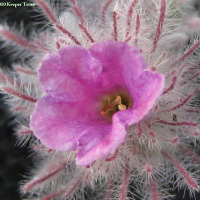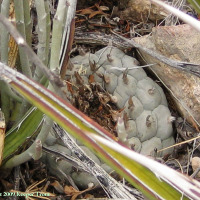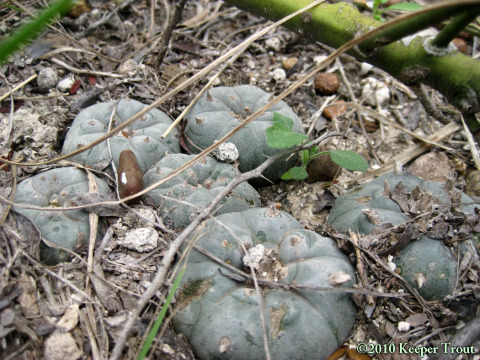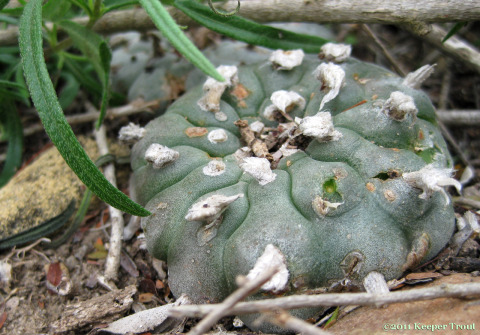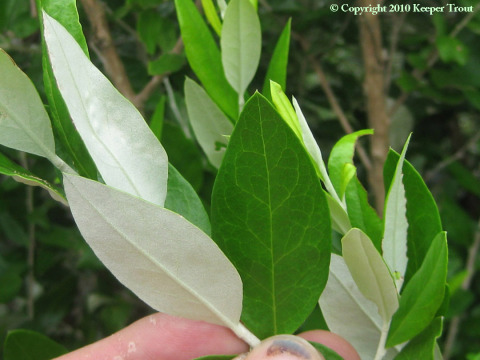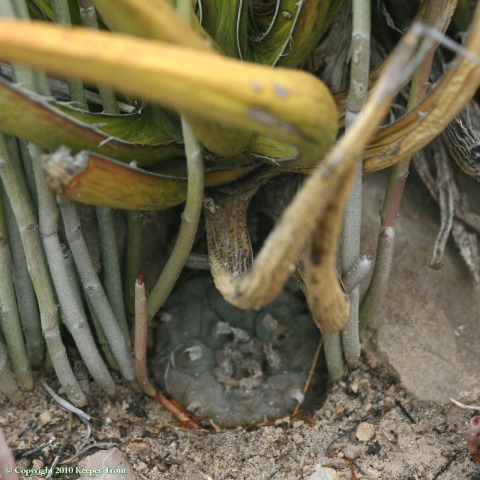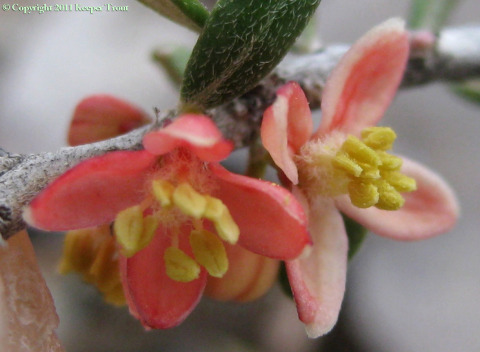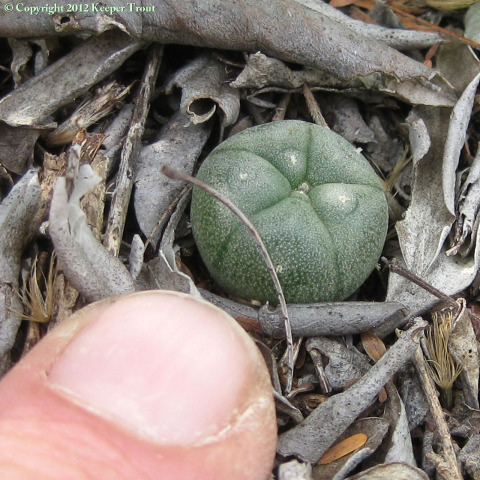Flora associated with Lophophora williamsii in Texas
Common vegetation in the Tamaulipan Brushland:
(AKA “chaparral” or “thorn scrub” or “desert scrub” or “scrub brush”)
Acacia amentacea (“black-brush acacia”) [Note 17], Castela texana (“amargoso”), Celtis pallida (“granjeno”), Karwinskia humboltiana (“coyotillo”), Leucophyllum frutescens (“cenizo”), Porlieria (Guaiacum) angustifolia (“guayacan”), Prosopis juliflora (“scrub mesquite”), Larrea tridentata (“gobernadora” or “creosote bush”) [but not in South Texas] and Condalia obovata (“brazil”).
In south Texas, Peyote grows in association with Yucca, Opuntia spp., Opuntia leptocaulis (“tasajillo”), cenizo, Echinocereus spp. (“pitaya”) & Acacia species
In Starr county, both Echinocereus pentalophus (“lady’s fingers”) and the charming endemic dwarf, Coryphantha robertii, are not infrequently associated with it in those areas near Rio Grande City where C. robertii is distributed.
A few of the many plants co-occurring in South Texas:
- Acacia berlandieri
- Acacia berlandieri
- Acacia rigidula
- Acacia rigidula
- Condalia spathulata
- Coryphantha robertii
- Draba cuneifola
- Dolichothele sphaerica
- Echinocereus enneacanthus
- Echinocactus texensis
- Porlieria angustifolia
- Karwinskia humboldtiana
- Karwinskia humboldtiana
- Koeberlinia spinosa
- Leucophyllum frutescens
- Leucophyllum frutescens
- Mammillaria hemispaerica
- Opuntia engelmanii
- Opuntia engelmanii
- Parkinsonia aculeata
- Jatropha dioica
- Schaferia cuneifolia
- Tequilia mexicana
- Tidestromia lanuginosa
Peyote’s highest populations in Texas, now, is in those areas referred to by many people as “impenetrable thorny scrub”.
In the Chihuahuan Desert it occurs in both the subdivision classified by desert scrub such as Larrea tridentata, Prosopis laevigata and Flourensia cernua, and also in the subdivision characterized by desert scrub incorporating many plants such as Agave lechuguilla and Yucca spp.
Plants associated with Chihuahuan Desert peyote and the percentage of frequency of co-occurrence according to Anderson 1980:
Larrea tridentata (“creosote bush”) over 75%
Jatropha dioica (“leather plant”) 70%
Opuntia leptocaulis (“pencil cactus”) 70%
Prosopis laevigata (“mesquite”) 70%
Agave lechuguilla (“lechuguilla”) 50%
Echinocactus horizonthalonius (“eagle’s claw cactus”) 50%
Mammillaria spp. (“fish-hook” or “nipple cactus”) 50%
Flourensia cernua (“tarbush”) 50%
Acacia spp. (“acacia”) 40%
Condalia spp. (“lotebush”) 40%
Coryphantha spp. 40%
Neolloydia spp. 40%
Yucca filifera (“yucca”) 40%
Hamatocactus spp. 40%
Coldenia (Tiquilia) canescens less than 40%
Euphorbia antisyphilitica (“wax plant”) less than 40%
Koeberlinia spinosa (“crucifixion thorn”) less than 40%
(The percentages given by Anderson were obtained as the ratio of the number of peyote sites where Anderson found that particular plant species to occur compared to the total number of peyote sites that he investigated in his 1960 dissertation. (That ratio was converted to a percentage.) Those 10 sites were Chihuahuan Desert populations and most, but not all, of them were Lophophora williamsii. One was Lophophora diffusa and another population was later determined by Dr. Terry to be Lophophora koehresii.)
From:
Anderson 1980 pages 149-151
Morgan 1983
and personal observations.
A few of the many plants co-occurring in West (Trans-Pecos) Texas:
- Acacia roemeriana
- Acacia roemeriana
- Ancistrocactus uncinatus
- Ariocarpus fissuratus
- Castella texanum
- Condalia ericoides
- Coryphantha ramillosa
- Cylindropuntia leptocaulis
- Echinocereus enneacanthus & Grusonia schottii
- Euphorbia antisyphilitica & a Bouteloua sp.
- Krameria ramossima
- Larrea tridentata (Castella flowers)
- Leucophyllum frutescens
- Leucophyllum frutescens
- Opuntia atrispina
- Opuntia camanchica
- Porlieria angustifolia
- Psora creanatum
- Tiquilia canescens
- Tiquilia greggii
- Yucca lechuguilla
Due primarily to the opportunity presenting itself, it was decided to attempt the photodocumention of as much of the associated flora as opportunity permitted. Seven sites containing Lophophora williamsii populations have been explored with this goal in mind during the course of other field work occurring in 2009-2014. Three of those populations were in Tamaulipan thornscrub (two in Starr County and one in Jim Hogg County) and four locales were in the Chihuahuan Desert (one each in Brewster, Presidio, Terrell & Val Verde). Some additional photographs showing close-up details of plants were obtained on properties in Maverick, Starr and Hildalgo Counties were peyote was not found. Those form the basis of the preliminary survey that this listing & photo collection represents. The basis of the listing at the Cactus Conservation website is simple, if we could find an instance of a plant growing with or near peyote that note was added to the list. If the observed relationship was one of being a nurse plant that was noted. In only a very few cases is a plant listed as associated based on someone else’s reported observation. A simple listing of those species and a representative sampling of images is included here. For far more images visit the CactusConservation.com website.
This should be regarded as an in-progress work presently limited to a very small sampling of Texas populations.
At all seven of those sites just mentioned there were at least one Acacia species, at least one Condalia species, some nature of at least one crust community, an Echinocactus species, at least one Echinocereus species, Jatropha dioica, Koeberlinia spinosa, at least one Leucophyllum species, assorted lichens, a Mammillaria species, at least one Opuntia species, Opuntia leptocaulis and at least one Yucca species.
Castela texana, at least one Coryphantha sp, an Ephedra, Porlieria, a Prosopis, Schaeferia, a Tiquilia, a Thymophylla and a Viguiera were observed at all but one site each and may have been overlooked at those exceptions.
Agave lechuguilla, Euphorbia antisyphilitica, and Larrea tridentata were present at all four West Texas sites.
As should be expected, Agave lechuguilla, Euphorbia antisyphilitica, and Larrea tridentata were absent from all South Texas sites. Karwinskia humboldtiana was present at all South Texas sites that included Lophophora as well all of the additional properties we visited in South Texas that lacked any Lophophora.
Many other plants are also potential nurse plants and I may easily have missed spotting or capturing an image. Numerous plants were encountered that have not yet been identified.
Many additional species were anticipated that have thusfar been elusive; and no doubt many instances of companion plants are yet to be recorded.
The photographic documentation project can be found online at the Cactus Conservation Institute website. It is still in mid-assembly and has much left to do but future work will continue to be added to these two pages at their website:
Flora associated with Lophophora williamsii in Texas
§
The Chihuahuan Desert of West (Trans-Pecos) Texas
§
The Tamaulipan Thornscrub of deep South Texas
South Texas: Tamaulipan thornscrub
(This is the biotic zone containing the South Texas Peyote Gardens)
Acacia berlandieri
Acacia rigidula
Acourtia runcinata
Astrophytum asterias
Atriplex spp.
Bahia absinthifolia
Calliandra conferta
Castela erecta var. texana
Celtis pallida
Cercidium texanum
Colubrina texensis
Condalia hookerii
Condalia spathulata
Cordia boissieri
Coryphantha robertii (now lumped with Escobaria emskoetteriana)
Coryphantha runyonii
Croton humilis
Croton incanus
Croton spp.
Dalea sp.
Dolichothele (Mammillaria) sphaerica
Draba cuneifolia
Echinocactus texensis
Echinocereus enneacanthus
Echinocereus pentalophus
Echinocereus poselgeri
Echinocereus reichenbachii var. fitchii
Eysenhardtia texana
Ephedra antisyphilitica
Euphorbia (Chamaesyce) spp.
Gochnatia hypoleuca
Hamatocactus setispinus
Isotoma spp.
Jatropha dioica
Hedeoma drummondii
Heliotropium curassavicum
Hibiscus martianus
Karwinskia humboldtiana
Koeberlinia spinosa
Krameria ramosissima
Lantana achyranthifolia
Lepidium austrinum
Leucophyllum frutescens
lichens (many)
Lindheimera texana
Lippia graveolens
Mammillaria heyderi
Manfreda spp.
Melampodium spp.
mosses (occassional not typical)
Nama hispidum
Oenanthera laciniata
Opuntia engelmannii var. lindheimeri
Opuntia leptocaulis
Palafoxia texana
Parthenium hysterophorus
Parthenium incanum
Pennisetum ciliare
Pithecellobium flexicaule
Polanisia dodecandra
Porlieria angustifolia
Prosopis glandulosa
Prosopis reptans
Salvia ballotaeflora
Schaefferia cuneifolia
Sclerocactus megarhizus
Spermolepis echinus
Suaeda tampicensis
Thamnosma texana var. texana
Thymophylla pentachaeta
Thymophylla tenuiloba
Tidestromia lanuginosa
Tiquilla mexicana
Verbena quadrangulata
Viguiera spp.
Xylothamia palmeri
Zexmenia (Jeffea) brevifolia
Zexmenia (Weddelia) hispida
Yucca treculeana
West Texas: Chihuahuan desert
Acacia berlandieri
Acacia greggii var. wrightii
Acacia rigidula
Acacia roemeriana
Agave lechuguilla
Aloysia wrightii
Ariocarpus fissuratus commonly near Lophophora but usually not together.
Aspicarpa hyssopifolia
Bahia absinthifolia
Baileyana multiradiata
Bernardia obovata
Bouteloua spp.
Buddleja marrubifolia
Calliandra conferta
Castella erecta var. texana
Celtis pallida
Ceanothus greggii
Condalia ericoides
Condaliaspecies
Condalia warnockii
Coryphantha echinus
Coryphantha ramillosa
Coryphantha tuberculosa
crust communities (many)
Dalea formosa
Dalea jamesii
Dasylirion texanum
Echinocactus horizonthalonius – same comment as Ariocarpus fissuratus
Echinocactus texensis
Echinocereus coccineus (often in area but only occasionally together)
Echinocereus dasyacanthus (often found nearby but rarely together)
Echinocereus enneacanthus
Echinocereus pectinatus var. wenigeri
Echinocereus stramineus
Echinocereus viridiflorus russanthus
Ephedra antisyphilitica
Ephedra trifurca
Epithelantha bokei
Epithelantha micromeris
Euphorbia antisyphilitica
Ferocactus hamatacanthus
Forestiera angustifolia
Forestiera spp.
Fouquieria splendens
assorted grass species
Heliotropium torreyi
Jatropha dioica
Koeberlinia spinosa
Larrea tridentata
Lesquerella spp.
Leucelene ericoides
Leucophyllum candidum
Leucophyllum frutescens
Leucophyllum minus
lichens
Lippia graveolens
liverworts
Lycium berlandieri
Lycium spp.
lycopods (clubmoss)
Mahonia (Berberis) trifoliolata
Mammillaria heyderi (common, often unclear which came first)
Mammillaria lasiacantha
Mammillaria meiacantha (nearby but not together)
Mimosa biuncifera
Mimosa spp.
Mortonia scabrella
Nerisyrenia camporum
Notholaena sinuata
Opuntia (Grusonia) aggeria
Opuntia camanchica
Opuntia engelmannii
Opuntia leptocaulis
Opuntia mackensenii minor
Opuntia rufida
Opuntia schottii
Opuntia sp.
Opuntia strigl
Petrogenia repens
Placidium lacinulatum
Porlieria (Guaiacum) angustifolia
Portulaca mundula
Prosopis glandulosa
Psora crenata
Ruellia spp.
Salvia ballotaeflora
Schaefferia cuneifolia
Sclerocactus uncinata
Selaginella lepidophylla
Selaginella spp.
Tecoma stans
Telosiphonia macrosiphon
Thamnosma texana var. purpurea
Thymophylla acerosa
Thymophylla pentachaeta
Tiquilia canescens
Tiquilia greggii
Tiquilia mexicana
Tiquilia sp.
Verbena sp.
Viguiera stenoloba
Yucca elata
Yucca reverchoni
Yucca thompsoniana
Yucca torreyi
Mexico: A similar project is needed for the populations in Mexico. Due to the wide range of Lophophora in Mexico that will be a tremendous undertaking.
Bohata et al 2005 noted observing the following cactus species with Lophophora in Mexico:
Ariocarpus fissuratus
Ariocarpus fissuratus subsp. bravoanus
Ariocarpus fissuratus subsp. hintonii
Ariocarpus fissuratus subsp. lloydii
Ariocarpus kotschoubeyanus
Ariocarpus retusus
Ariocarpus retusus f. elongatus
Ariocarpus retusus subsp. scapharostroides
Ancistrocactus brevihamatus
Ancistrocactus scheerii
Ancistrocactus uncinatus
Ancistrocactus uncinatus subsp. wrightii
Astrophytum myriostigma
Astrophytum myriostigma subsp. columnaris
Astrophytum asterias
Astrophytum capricorne
Astrophytum capricorne f. major
Astrophytum capricorne f. minor
Astrophytum capricorne subsp. niveum
Astrophytum capricorne subsp. senile var. aureum
“and many others”
Observable in Cactus Conservation Institute photographs online:
Agave spp.
Castella erecta texanum
Coryphantha sp.
Dyckia sp.
Echinocactus platyacanthus
Echinocereus spp
Mammillaria spp.
Sclerocactus uncinatus
Stenocactus spp.
Thelocactus spp.
Tiquilia sp.
Viguiera sp
Other cacti

